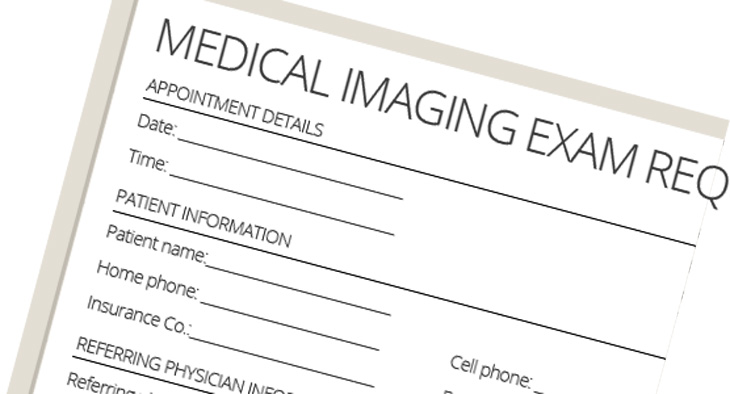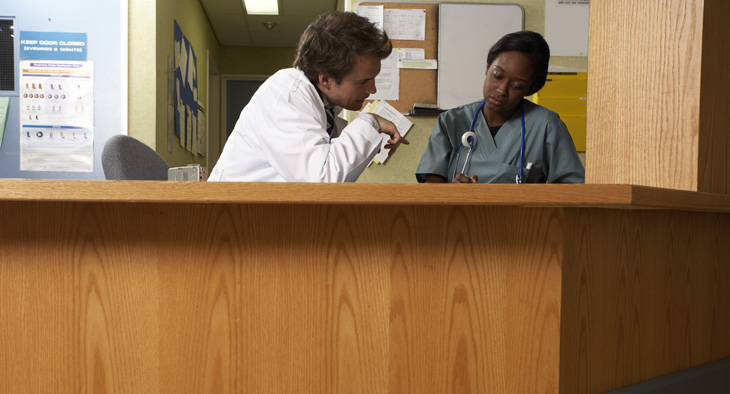In this section you will review diagnostic test vocabulary, then practise writing a diagnosis and diagnostic study request.
2. Diagnostic test types.

Read and complete the descriptions from the previous exercise. This exercise is in two parts.
Part 1.
Part 2.
3. Diagnostic imaging protocol.

In the following exercise you will read a summary of the protocol for nurse practitioners when requesting diagnostic imaging. The following abbreviations appear in the summary. Do you know what they stand for? Type your answers and then listen to see if you are right.
4. Diagnostic imaging protocol.

Read the Emergency Department protocol. Then listen to the statements below it and decide if they are true or false.
Responsibilities of the Emergency Nurse Practitioner (ENP)
To provide appropriate requests of diagnostic imaging for patients following an endorsed clinical protocol.
To ensure that request documentation is correct and that appropriate images are requested, that radiation safety protocols are adhered to, and that the image results are reviewed and inform clinical decisions.
Scope for requests
The following radiographs can be ordered by endorsed nurse practitioners:
Upper limb – clavicle, humerus, elbow, forearm, wrist, hand, fingers
Lower limb – knee, tibia, fibula, ankle, foot, toes
Assessment
The ENP carries out a thorough assessment of a patient, formulates a potential diagnosis and requests imaging to confirm the diagnosis or eliminate a differential diagnosis.
Requests
Imaging requests must follow Emergency Department protocol and have department approval.
The ENP must refer the patient to an SMP when the imaging request is not within the scope of practice, for example, in the case of a pregnant patient.
Documentation
This must be legible, unambiguous and follow guidelines.
Requests should include the following:
Patient name, date of birth, UMRN, address ED location
Requesting clinician’s name, signature, designation and contact number
Date and time of request
Relevant clinical notes
Imaging requested
Imaging requests should be recorded on the patient’s medical record, indicating the image, views and reason for the request.
Test results should also be documented in the patient medical record, once they are available, along with the implications for diagnosis and management.
This information must also be added to the EDIS clinical comments screen.
Follow-up
ENP reviews the radiology test result and determines the significance to the diagnosis and the patient treatment.
You can see the sentences here.
5. Diagnostic imaging protocol: Correct verbs.
Now complete the summary by choosing the most appropriate verb for each space.
6. Clinical conditions and diagnostic tests.

Listen to the descriptions of diagnostic information and choose the correct
clinical problem.
Now listen and match four more examples.
You can see the transcript of the descriptions here.
8. Vocabulary: Clinical conditions.

Can you remember? Use the words to complete the descriptions.
Now complete the remaining examples.
9. Pronunciation: Vowel sounds.
Many words in this section contain the /aɪ/ sound when pronounced. This is the vowel sound in words like time, compile, buy, try, etc. Say the words to yourself and put them in the correct box. If they contain the /aɪ/ sound, put them in the /aɪ/ box.
Now listen and repeat the list of words.
arthritis, biopsy, clavicle, clinical, conjunctivitis, diagnostic, diarrhoea, disease, guideline, illness, imaging, laryngitis, limb, microscopy, mild, rapid, required, sign, signature, skin, urine, viral, virus
10. Listen: Imaging referrals.

Listen to part of a talk from a training video for medical practitioners. The talk is about making imaging requests, or referrals. Listen and put the topics in the order that they are talked about.
12. Listen and read: The right choice of words.
Read and complete the transcript by choosing the most appropriate options.
13. Listen and take note.
Listen to a spoken medical history and observations from a patient’s physical examination. Complete the notes by typing the missing words in the boxes. Listen and take notes.
14. Read and diagnose.
Now listen again and read the transcript of the recording from the previous exercise. Choose a primary and secondary diagnosis for this patient.
15. Read and complete.
Now try to memorise the medical history and observations from the patient’s physical examination. When you are ready, tap or click on “Start”. Most of the words will disappear. Type in the missing words. (Tip: You can click on each space to see the first letter of the missing word.)
Writing Tutorial 1.
In this tutorial you will write to your tutor describing a medical history and requesting a diagnostic study.
Think of a recent or hypothetical case that requires some kind of diagnostic study. Write the medical history and diagnostic study request.
Include the following about the patient and case:
- History
- Physical examination
- Diagnostic studies to request
- Clinical question for diagnostic study request
Write approximately 200 words.
